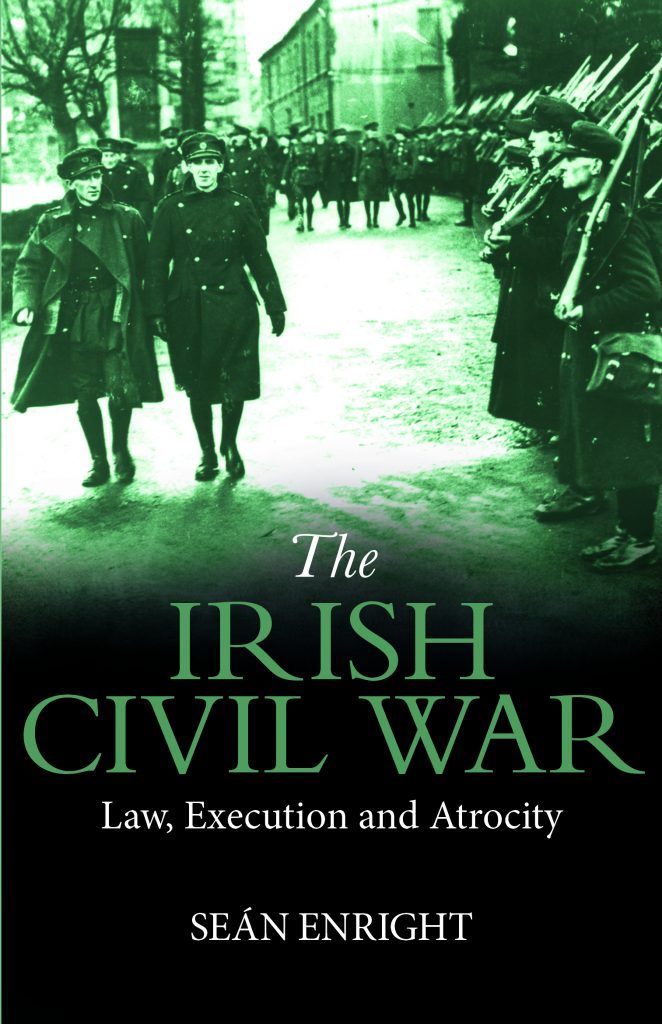A reminder from a hundred years ago, that the Rule of Law is a most delicate thing.
All that day a huge plume of smoke hung over Dublin, as the Four Courts and the Public Record Office burned and in the swirling wind, charred medieval legal documents drifted. The Irish civil war had begun.
The war was fought over the Anglo-Irish Treaty, which provided limited autonomy for the 26 counties and the partition of the north. The pro-treaty faction had formed a government, and its first step was the storming of the Four Courts, which anti-treaty fighters had occupied. In Britain, Churchill, the minister responsible for implementing independence was sanguine; ‘better a country without a library than a library without a country.’
The author paints a compelling view of the crisis. Under threat of assassination, the cabinet of the provisional government camped out in a top floor apartment under heavy guard. During long evenings, they smoked, played bridge, and read the news from a volatile Europe: civil war in Russia, Greece and Turkey, and revolutions in Italy and Greece and Germany’s inexorable slide into economic ruin.
At night, the ministers slept on mattresses on the floors, and in the morning, the mattresses were rolled up and the business of government began. The cabinet, all young men steeped in revolutionary struggle, now faced more prosaic challenges: meeting the public sector pay bill, keeping schools and hospitals open and the economy running. The legal system was already at the point of collapse.

The beleaguered pro-treaty government concluded that the civil war could not be won by conventional military victories and the financial cost was edging the country towards bankruptcy. This was the driving fear: that the money would run out and the police, army and civil service would unravel. In these circumstances, the government decided to introduce military courts to try prisoners captured with arms. 83 prisoners were executed in the months that followed.
During the Dail debates, assurances were given by the government that the trials by military courts would be fair and regulations ensuring legal representation were considered and approved.
Here, the author points out that no statute was ever passed because legislation to create military courts required the personal signature of King George of England. Seeking his signature to execute anti-treaty fighters would be a political embarrassment and to avoid this, the provisional government simply passed a motion in the Dail. The motion lacked any force of law, and this is one of the reasons why the execution policy became tainted with illegality. With this final obstacle overcome, the government issued a proclamation that persons ‘taken in arms’ would be tried by military court and ‘suffer death’. The executions began.
Almost immediately, a crisis arose. Erskine Childers, an anti-treaty activist, was captured with a handgun. He was tried by military court, convicted, and sentenced to death. He brought a challenge by a writ of habeas corpus to the High Court in Dublin.
While the court sat, the cabinet talked of their fears that ‘some cracked judge’ might order the release of the prisoner. The consequences of an adverse ruling were that the execution policy would be ruled unlawful and that the prisoners already executed had been unlawfully killed. The crisis was grave and there were tense discussions about what should happen if the judge should ‘abuse his position’ (rule against the government). Some cabinet ministers argued that if the court did rule against the government, then Childers should be brought out and shot. The country had come close to dictatorship.
Legal argument in the Childers case went on late into the evening. With the Four Courts in ruins, the Master of the Rolls delivered his judgment in the Great Hall of Kings Inns by candlelight: he ruled for the government. Counsel for Childers gave notice of an appeal but crucially did not ask for ‘a stay pending appeal’. The provisional government seized the opportunity, and later that night Childers was brought out to face the firing squad. Childers, in his crumpled cream suit, was difficult to the last pointing out that there was no doctor present, as the regulations required. A doctor was sent for. Childers shared cigarettes with firing squad as the sun rose.
The executions resumed and within a few weeks the government went a step further and executed four prisoners without trial as a reprisal for the shooting of a member of the Dail. The Mountjoy executions, as they became known, marked the abandonment of the rule of law.
That same day, the provisional government ordered the creation of army committees which would substantially replace military courts. The trial regulations approved by the Dail were swept away and trial by committee soon became the new normal. Trial would follow immediately after capture; there would be no delay, no defence lawyers and some prisoners would not even be present at their trials.
Conviction put the fate of the prisoner in the hands of the commanding officer of the new national army. The weight of evidence adduced by the author suggests that it was not culpability that determined life or death, but intelligence about the prisoner and tactical considerations that determined who would die and who would be spared.
The focus of the execution policy was on the rank and file of the anti-treaty fighters, but soon assumed an even more bitter twist. The national army command ordered that ‘in every case of outrage in any battalion area, three men will be executed’. There was a large bank of prisoners under the sentence of death and here, perhaps, is the ugliest truth. When government troops were attacked, the army searched through the prisoners under sentence of death and executed prisoners from the area where the ambush had taken place. Whether by chance or design, the policy of the national army morphed into reprisal executions.
The justification for trials by military court rested on the contention that ordinary law had broken down and the army of the provisional government needed to ‘stand in the gap’. The author suggests that this may have been so in the autumn of 1922, but the anti-treaty faction had collapsed by the spring, and executions continued until the summer. The last to be executed were two inept teenage bank robbers who had nothing to do with the war. It was at this point that the Dail began to wrestle control back from the national army.
Was the government right? Judge Enright does not attempt a direct answer but relates the evidence without comment and touches here and there on the suffering endured by civilians; internment, grief hunger and exile. This book is an easy read but sometimes a painful one.
One of the sub-stories is one we can all relate to: pro bono work by a small group of lawyers who defended capital trials, often at considerable personal risk. Two of these, Kingsmill-Moore and Conor Maguire would later become Justices of the Supreme Court.
There are many themes in this compelling book: the fall-out from Versailles and the fragmentation of an empire, but perhaps the enduring theme is the collapse of the rule of law in times of crisis. The rule of law is a most delicate thing, and it is all that stands between the citizen and anarchy. The Ukrainian crisis has shown how fragile international law can be. In America, the efforts of Republicans to undermine the Justice Department and repeal an inconvenient statute for political ends is a most dangerous step.

Master Landale was called to the Bar in 1988 and practised for 27 years on the Northern Circuit. In 2015, she became a Circuit Judge and sits in crime in Manchester. She was made a Bencher in 2019.


